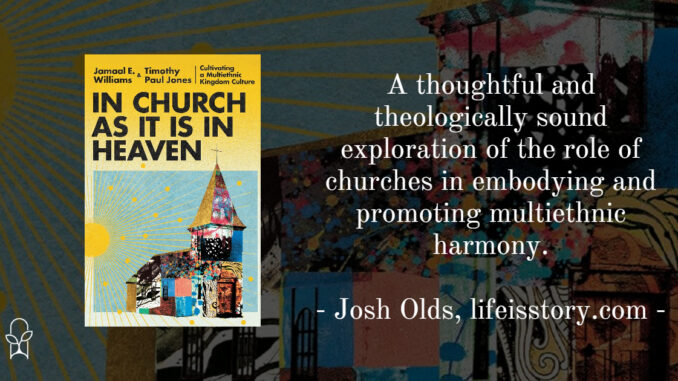
Published by IVP on June 13, 2023
Genres: Non-Fiction, Racial Reconciliation
Buy on Amazon
Goodreads

Heaven is multiethnic. Are you ready for that?
The Bible tells us that the congregation gathered around God's heavenly throne will be "a vast multitude from every nation, tribe, people, and language," all singing the praises of the Lamb. God's intention has always been to delight for all eternity in a redeemed community of ethnic diversity.
But this diverse community shouldn't have to wait until eternity to begin! It can be a reality in our own local churches here and now. Patterned after a worship service, In Church as It Is in Heaven gives biblical warrant for such a community and shows how multiethnic churches provide a unique apologetic for the gospel. Along the way, the authors tell the story of their own church―a majority-white congregation which is being transformed into a family that reflects the diversity of heaven.
The multiethnic kingdom is not just a nice idea, or an abstract theory. It's a reality―one we can enter into today.
What interested me the most with In Church as it is in Heaven was the subtitle: Cultivating a Multiethnic Kingdom Culture. I thought that phrase was interesting since, in my experience, many churches desire diversity, or multi-ethnicity, but often do so under a church monoculture that looks and feels like whatever is the church’s majority culture. There is a desire to look diverse without that diversity having any power. Does Kingdom Culture mean a monoculture that gives preference toward the majority or does it mean a multicultural expression of faith that reflects the multicultural, multiethnic Kingdom of God? On every page, In Church as it is in Heaven resoundingly shouts that it’s the latter.
Like a lot of books dealing with building multiethnic communities, this book is coauthored by a multiethnic duo. Jamaal E. Williams is Black and the lead pastor of Sojourn Church Midtown in Louisville, Kentucky. His first pastoral call was to an historic African-American church and has a doctorate in Black Church Leadership. Timothy Paul Jones is White and serves as a staff pastor at Sojourn while also being the chair of the apologetics, ethics, and philosophy department at The Southern Baptist Theological Seminary. This lends weight to and gives an example of the goal of the book—folks of different ethnic backgrounds coming together for the flourishing of the church.
I think it’s also important that this is coming from Southern Baptist pastors and academics. The Southern Baptist church was founded, as one might guess from the name, as part of the North/South break in the Civil War, with Southern Baptists fighting to maintain their right to enslave others. That history, along with the present struggle with the Southern Baptist Convention as it relates to racial reconciliation makes In Church as it is in Heaven as powerful step forward toward acknowledging historical injustices in the SBC and moving toward a more biblical, multiethnic, multicultural vision for the Church.
The book’s structure mirrors a church service, with sections corresponding to traditional elements like a call to worship and communion. Each section presents a problem related to establishing a multiethnic church, proposes a liturgical response, and outlines the ideal outcome. This format underlines the book’s core message: The church service itself can be a medium for addressing and transforming racial divides. Williams and Jones use their own church as the primary example for building this multiethnic Kingdom culture—not because their church is perfect, but because it directly relates to their own experiences. In Church as it is in Heaven is thus able to offer a blueprint of something that has worked practically in a thriving church.
One limitation of the book, as mentioned by the authors in the beginning, is that because the book is from their personal and professional experiences, their view of what is “multiethnic” is limited to Black and White. While this is a predominant divide in American culture, it is by no means the only divide. Williams and Jones call this divide “the starkest one in our social context” and write that their concepts can be adapted to other contexts. Nonetheless, this does feel like a significant limitation. How might the conversation regarding building a multicultural church change when one is talking about three or more cultures? There is no language divide between Black Americans and White Americans. How does the conversation change when the cultures speak different languages? I appreciate the authors recognizing their limitation, but wished they had taken some time in the book to consider other cultures.
Overall, In Church as It Is in Heaven is a thoughtful and theologically sound exploration of the role of churches in embodying and promoting multiethnic harmony. It combines a robust scriptural foundation with a clear vision for how churches can reflect heaven’s diversity on earth. The book’s structure makes it stand out as unique and it presents the church as the solution—rather than part of the problem—of racial reconciliation.
